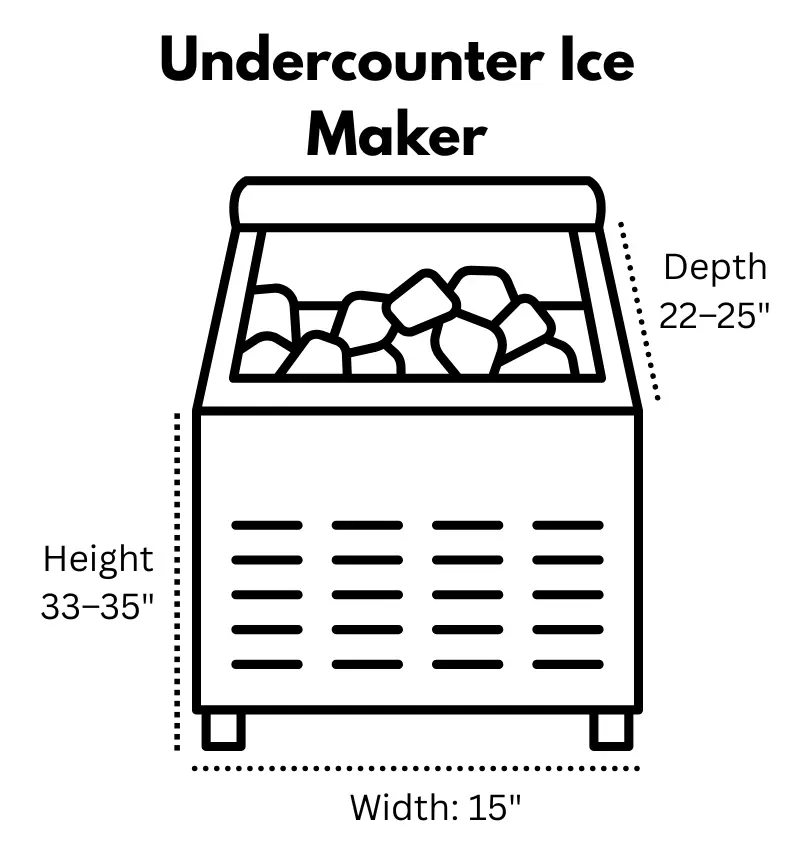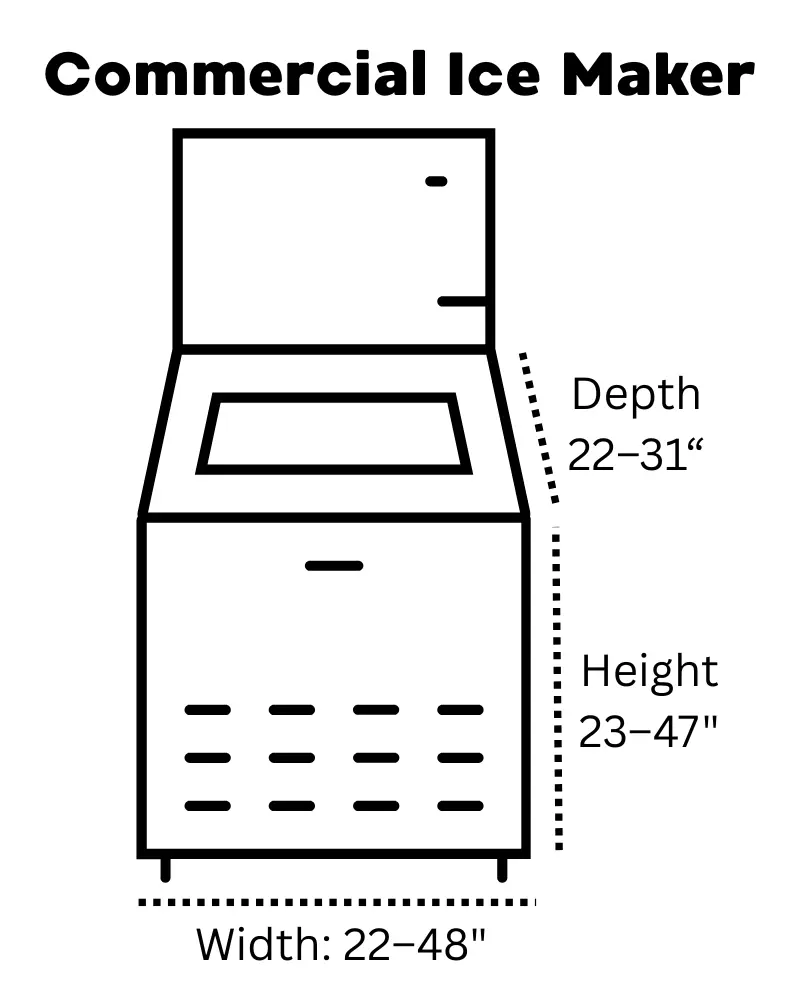Ice maker dimensions vary by type. Undercounter models are typically 15″ wide, 33–35″ high, and 22–25″ deep. Countertop ice makers range from 9–14″ wide, 12–17″ high, and 13–16″ deep. Commercial units are larger, about 22–48″ wide, 23–47″ high, and 22–31″ deep. Always check manufacturer specifications to ensure the right fit for your space.
| Type | Width | Height | Depth |
|---|---|---|---|
| Undercounter | 15 inches | 33–35 inches | 22–25 inches |
| Countertop | 9–14 inches | 12–17 inches | 13–16 inches |
| Commercial | 22–48 inches | 23–47 inches | 22–31 inches |
Why Ice Maker Size Matters
Choosing the right size ice maker impacts not only your ice supply but also your space, efficiency, and energy use. The size of an ice maker plays a critical role in how well it fits your needs. While it may be tempting to focus solely on how much ice a unit can produce, its physical dimensions affect much more than capacity.
A model that’s too large can waste energy and take up valuable space, while one that’s too small may leave you short during peak usage times. Smaller ice makers are great for tight spaces like apartments or RVs. They’re generally easier to install and more energy-efficient, but their limited output and storage may not suit larger households or businesses.
In contrast, larger units offer higher production but often require more ventilation, drainage, and electrical power—factors that add complexity and cost.
Beyond functionality, improper sizing can affect long-term performance. A poorly ventilated unit in a cramped space may overheat or wear out faster. That’s why balancing production needs with available space and energy constraints is so important.
Ultimately, understanding ice maker dimensions helps you choose a model that works efficiently within your space—without sacrificing comfort, reliability, or long-term value.
Common Types of Ice Makers and Their Dimensions
Ice makers come in several styles, each with its own typical dimensions based on usage and installation type. Whether you’re outfitting a compact kitchen or a bustling restaurant, knowing the standard sizes of each type helps you make a more informed, space-conscious choice.
Portable/Countertop Ice Makers
Ideal for small spaces and mobility, portable ice makers usually measure around 9 to 15 inches wide.
These compact units are perfect for apartments, dorm rooms, RVs, or even outdoor gatherings. Their small footprint—often under 17 inches in height—makes them easy to move and store.
However, this convenience comes with tradeoffs. While portable ice makers are user-friendly and require no plumbing, they generally have limited ice production and storage. You may find yourself refilling them often, especially during parties or warm months.

Undercounter/Built-in Ice Makers
Designed to fit seamlessly under countertops, these models typically measure 15 inches wide and 25 to 35 inches high.
Built-in ice makers are ideal for homeowners who want a permanent, sleek solution. They offer greater capacity than countertop models while maintaining a clean aesthetic.
However, installation can be more complex, requiring proper ventilation and a drain line. It’s essential to measure your cabinet openings precisely, as even an extra inch of width can determine whether the unit fits or not.

Freestanding Ice Makers
Freestanding units offer higher capacity and range in width from 20 to over 30 inches, with variable heights depending on the model.
These models are versatile and can be installed almost anywhere, provided there’s adequate space and ventilation. They typically produce more ice than undercounter units, making them suitable for large households or small businesses. However, they demand more floor space and may be noisier, especially in open areas.
Commercial Ice Makers
For large-scale needs, commercial machines can exceed 48 inches in width and require dedicated space planning.
Commercial ice makers are built for high-volume production, commonly found in hotels, bars, and healthcare settings. While they excel in output and efficiency, they pose significant challenges in terms of installation, maintenance, and space requirements. Additionally, their size and utility needs may require professional setup, increasing overall costs.

How to Measure for an Ice Maker
Accurately measuring your space ensures a proper fit and optimal performance from your ice maker.
Start by measuring the width, depth, and height of the intended installation area. Be sure to leave at least 1 to 2 inches of clearance on all sides for ventilation, especially with undercounter or freestanding units. Without adequate airflow, your ice maker may overheat or function inefficiently.
Next, account for door clearance and ensure nearby appliances or cabinetry won’t obstruct operation. Also, check for proper access to power, water lines, and drainage if required. Don’t forget the delivery path—larger units may not fit through doorways or narrow halls, making installation difficult.
Compact models fit more easily but may not meet high demand. Larger models provide more ice but require more space and resources. Balancing these tradeoffs is key to choosing a unit that works well in your environment.
Measuring carefully helps avoid surprises and ensures long-term satisfaction with your purchase.
Space Considerations Beyond Dimensions
It’s not just the width and height that matter — ventilation, drainage, and door clearance are equally important.
While the physical dimensions of an ice maker provide a starting point, true fit depends on a variety of other spatial factors. For example, without proper ventilation space—typically 1 to 2 inches around the unit—heat can build up, reducing efficiency and shortening the machine’s lifespan.
Additionally, many ice makers require a dedicated drain line, which may not be available in every location. Planning for water and power access is just as critical as the physical footprint. Neglecting these needs could mean costly modifications down the road.
Door swing and access are also easy to overlook. A machine wedged into a tight spot might fit, but poor clearance can make daily use awkward and frustrating.
Balancing compact installation with full functionality often involves tradeoffs, but addressing these space considerations early ensures smoother operation and a longer-lasting investment.
Matching Ice Maker Size to Your Usage Needs
The best ice maker for you is one that meets your daily ice consumption without taking up unnecessary space.
To make the right choice, start by estimating how much ice you typically use in a day. For instance, a family may only need 20–30 pounds daily, while a small café could require over 100. Matching output to usage is crucial—too small, and you’ll constantly run out; too large, and you’ll waste energy and space.
Moreover, consider peak demand times. Do you host gatherings often or run a seasonal business? If so, a higher-capacity model may be worth the tradeoff in size.
Keep in mind, though, that larger units may need more power, drainage, and ventilation. Balancing output with available space, utility access, and efficiency can be tricky—but it’s essential.
Ultimately, selecting an ice maker that aligns with your lifestyle ensures consistent performance, minimizes waste, and helps you make the most of your available space.
Installation Requirements and Clearance Guidelines
Every ice maker has specific installation needs, so knowing the required clearances and hookups is essential. Before purchasing, review the manufacturer’s specifications for ventilation, drainage, and electrical requirements.
For example, many undercounter and freestanding models require at least 1 to 2 inches of space around the unit to allow proper airflow. Without this clearance, the machine can overheat or operate inefficiently.
Additionally, most built-in or commercial models need a water supply line and a dedicated drain. If your space lacks these, installation may require costly plumbing upgrades. This makes it vital to balance performance expectations with your space’s current capabilities.
Clearance for door swing, drawer access, and rear connections also impacts daily use and maintenance. A model that technically fits might still be impractical if you can’t open it fully or service it easily.
In the end, considering installation requirements alongside dimensions ensures your ice maker functions safely, efficiently, and without constant frustration.
Tips for Small Spaces
If you’re working with limited room, here are smart ways to fit an efficient ice maker without compromising functionality. First, opt for a portable or compact countertop model, which typically requires minimal space and no plumbing.
These are ideal for apartments, RVs, or offices, though they may produce less ice and need manual refilling. Alternatively, consider slim undercounter models designed specifically for tight installations. While they save floor space, they may need ventilation clearance, so plan accordingly.
Moreover, use vertical storage solutions or adjustable shelving to free up counter and cabinet space. The key tradeoff is balancing ice output with physical footprint. While smaller units offer convenience, they may not meet high demand.
Ultimately, smart planning ensures you gain functionality without overwhelming your limited space.
Conclusion
Finding the perfect ice maker starts with understanding dimensions — because the right fit ensures reliable performance and convenience. Balancing space, capacity, and installation needs may involve tradeoffs, but thoughtful planning helps you avoid costly mistakes and enjoy efficient, long-lasting ice production tailored to your specific needs.
FAQs
What size ice maker do I need for my home?
The ideal size depends on your daily ice usage. For small households, compact or portable models producing 20–30 pounds of ice per day usually suffice. Larger families or frequent entertainers may need undercounter or freestanding units with higher capacity.
How much clearance do I need around my ice maker?
Most ice makers require at least 1 to 2 inches of clearance on all sides to ensure proper ventilation and prevent overheating. Additionally, consider door swing and access to water and drain connections for smooth operation and maintenance.
Can I install a portable ice maker anywhere?
Portable ice makers are flexible and don’t require plumbing, making them easy to place on countertops or tables. However, they still need a nearby power source and enough space to allow ice removal and airflow.
What are the space challenges with commercial ice makers?
Commercial models often require dedicated space for ventilation, drainage, and electrical hookups. Their larger size can complicate installation and delivery, so careful planning and sometimes professional assistance are necessary.
How do I balance ice production needs with available space?
Start by assessing your typical daily ice demand, then compare it against the physical dimensions and installation requirements of available models. Choosing a unit that fits your space but meets your consumption avoids waste and ensures reliable performance.